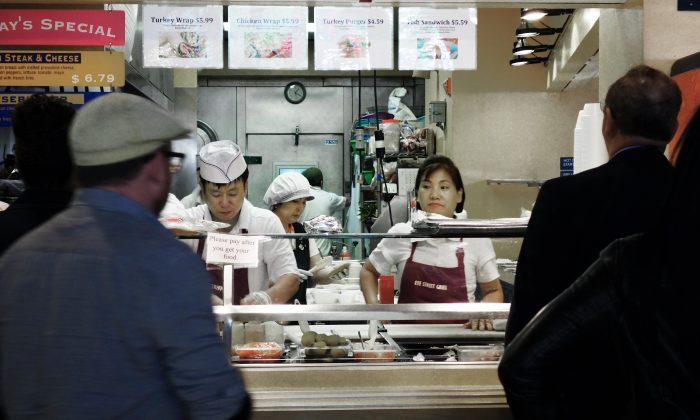The average American’s disposable income (DPI—the income after paying taxes and increasing ones retirement account) is shrinking, curtailing buying habits and preventing individuals from increasing their nest eggs—needed when laid off, during a bout of illness, or when one retires.
Although statistics show an improvement in disposable income at the end of 2012, an April 26 article on the Safehaven website suggests that the increase was not because of an improvement in the economy, but that the “upward surge in real per capita disposable income was merely an artifact of payroll ‘gaming’ in anticipation of increasing tax rates.”
Real disposable income increased by 6.2 percent during the last quarter of 2012, then took a plunge of 5.3 percent during the first quarter of this year, an April 26 article on the Wells Fargo & Co. website states.
According to market analysts, a continued increase in gasoline prices is affecting disposable income. The U.S. Energy Information Administration states that U.S. gasoline prices are trending up, from $3.52 on April 29 to $3.60 on May 13, an increase of $0.08.
Food prices are also on the rise, states The Crop website on May 13. The Food and Agriculture Organization Food Price Index—a measure of international prices of a basket of food commodities—was up 1 percent in April when compared to March. Food price increases were mostly the result of increases in dairy and meat products.
Loss of disposable income also affects the personal savings rate. The savings rate after taxes was around 4 percent in 2012. This is 1.5 percent below the 5.5 percent average savings rate of the 1990s, 4.6 percent lower than 8.6 percent in the 1980s, and 5.6 percent down from 9.6 percent in the 1970s, according to a February 2013 article on the Brookings Institution’s Hamilton Project website.
Savings by the average American totaled $329.1 billion in March, $1.8 billion lower than during the prior month. The personal savings rate, calculated as a percentage of disposable personal income, was unchanged at 2.7 percent in March compared to February, according to an April 29 release by the U.S. Bureau of Economic Analysis (BEA).
“The US savings rate—measured as the percent of personal income—fell to a post-recession low of 2.6 percent in the first quarter of 2013. The first quarter saw personal income decline by 0.8 and personal savings decline by a whopping 44.6 percent,” a May 2 article on the Savings and Retirement Foundation (SRF) website states.
The SRF article does not blame the economy or less disposable income for the decrease in the savings rate, but the dividend tax, suggesting that firms handed out dividends in 2012 to help their stockholders avoid the higher 2013 tax rate.
The BEA release states that personal income, presented in current dollars and month-to-month, increased by 2.6 percent in December 2012, decreased 3.6 percent in January, increased 1.1 percent in February, and then rose by 0.2 percent in March.
“As consumers in the U.S. economy experienced a contraction in their income, their expenses increased. Personal outlays increased 4.1% in the first quarter of 2013 compared to the first quarter of 2012,” an April 29 article on the Profit Confidential website states.
Consumer spending is affected by many factors. For example, America’s wealthiest 20 percent own 93 percent of America’s non-home wealth, according to a May 13 article on the Economy in Crisis website.
Researchers suggest that the upper echelon’s income is greatly derived from investing in the stock market, while those of the lower social echelon rely mostly on their salaries.
“For Americans with incomes over $10 million, nearly half of their income comes from capital gains and dividends. … From 2002 to 2007, two-thirds of all income went to the richest 1%. Then, in the first year after the recession, a startling 93% of all new income went to the richest 1%,” leaving society’s lower echelon out in the cold, the Economy in Crisis article suggests.
Affecting Consumer Spending Habits
U.S. economic data, published by the federal government and market research firms, is not promising, indicating that the average consumer has not returned to pre-financial meltdown spending levels.
Wages are no longer high enough to allow for spending sprees. The cost of consumer products is on the rise and even savings have to be curtailed.
The U-6 unemployment rate, which includes the jobless as well as part-time workers who desire full-time jobs, was 13.9 percent in April, up 1 percent from March, according to alternative measures of labor underutilization, published by the Bureau of Labor Statistics. Most consumers just don’t have the financial wherewithal to shop.
“Consumers in the U.S. economy are struggling and businesses are not selling. … The U.S. economy is consumer-focused—consumer spending makes up a huge chunk of our gross domestic product (GDP),” the Profit Confidential article states.
Although corporate incomes are rising, it is not as a result of increasing revenues, which are either flat or have risen only slightly. Financial analysts suggest that corporate income is on the rise because many companies cut expenses due to layoffs, reduce working hours or salaries, streamline processes, close or sell unprofitable divisions, or move production overseas.
A May 3 U.S. Census Bureau news release indicates that manufacturers are hurting and new orders were down by a total of $19.5 billion, or 4 percent, in March—another sign of curtailed spending habits.
Many factors affect consumer spending, such as the contraction of disposable income, unemployment, and rising living costs.
“Real economic growth takes place in a country when the standard of living increases and its citizens are able to find work, save, and spend. The U.S. economy is in the complete opposite situation today. Take away the rising stock market, and the economy is pathetic,” the Profit Confidential article suggests.





Friends Read Free